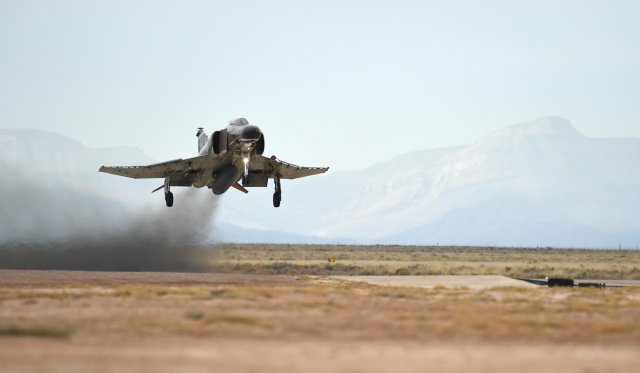
The US Air Force bid farewell to the final F-4 Phantom II during a ceremony Wednesday at Holloman AFB, N.M. More than 500 people gathered at Holloman to watch the flight of the final F-4, AF 349, piloted by Lt. Col. Ronald King, the Det. 1, 82nd Aerial Target Squadron commander. The F-4 was originally developed for the US Navy and entered service in 1961. The Air Force approved the F-4C a year later and conducted the first flight in May 1963. The Phantom II fighter/bomber became operational in the Air Force in 1964 and was the “workhorse and symbol of American airpower throughout the Vietnam War,” said 53rd Wing commander Col. Adrian Spain during the ceremony.
All five American aces in Vietnam flew the F-4 as they scored their kills. The Air Force variant is credited with 175.5 aerial victories during the war and the Marine Corps and Navy scored another 57, said Spain. The Phantom II was USAF’s dominant tactical aircraft through most of the 1960s and 1970s, with production ending in 1979. The F-4 was optimized for many specialized missions and evolved through more than 40 variants, achieving excellence in air superiority, close air support, interception, reconnaissance, suppression of enemy air defense, and more.
USAF acquired 2,840 F-4s, the Navy-Marine Corps acquired 1,264, and foreign nations purchased 1,091. The F-4 also is the only aircraft flown by both the Air Force Thunderbirds and the Navy Blue Angels. Known by many names, including Rhino, Double Ugly, and Old Smokey, the Air Force later converted 317 F-4s to aerial targets.
An F-35 strike fighter targeted the last of the unmanned QF-4s during a training mission at White Sands Missile Range, N.M., in August. The QF-4s will be replaced with modified F-16s.
Photo: The Air Force’s last F-4 Phantom II takes off from Holloman AFB, N.M., o on Dec. 21, 2016. Air Force photo by SSgt. Eboni Prince.
Source: Air Force Magazine
